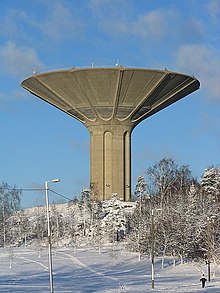This article needs additional citations for verification. (April 2020) |




East Helsinki (Finnish: Itä-Helsinki, Swedish: Östra Helsingfors) is an area in Helsinki, Finland, usually thought to comprise the city's eastern and south-eastern major districts (Finnish: suurpiiri, Swedish: stordistrikt), including the districts of Vartiokylä, Myllypuro, Mellunkylä, Vuosaari, Herttoniemi, Laajasalo and Kulosaari. With the exception of Kulosaari, the buildings in the area are relatively new – most have been built in the 1960s or later – and constitute relatively densely inhabited suburbs, except for the southern part of Laajasalo and most of Kulosaari. On the other side of the bridge to the west of Kulosaari is Helsinki Downtown (Finnish: Helsingin kantakaupunki, Swedish: Helsingfors innerstad), the so-called "South Helsinki". Officially, the name "East Helsinki" is not found in the city's regional nomenclature, but it was a name created by the locals of the area.[1]

East Helsinki has had problems with unemployment and poverty, and immigrants and refugees are somewhat concentrated in the area's subsidised housing and city-owned apartments. Drug dealing is relatively common in East Helsinki.[2] This has led to a popular conception of East Helsinki as a problem-ridden area.[3] Kontula, quarter of the Mellunkylä district, has generally been considered one of the most notorious ghettos in particular.[4][5][6][7][8][9]
Public transport in East Helsinki is organised mainly through the Helsinki Metro, most of whose stops are located in the area, and feeder bus lines. The most important road connection to the city central from East Helsinki with car or bus runs along Itäväylä. One of Finland's largest shopping centres, Itis,[10] is located near Itäkeskus, the geographical centre of East Helsinki, and many public and commercial services for the area are concentrated there.
A major change took place in the area's infrastructure upon the completion of the Port of Vuosaari. Most of the existing port facilities in Helsinki were moved to the new seaport, which created increased economic activity in East Helsinki as well as released new areas for development in other parts of the city. As a logistics area, the Port of Vuosaari employs about 2,000 people, and through it, for example, bananas coming to Finland (about 5,000 containers a year), pass through the port to the main warehouses of the grocery stores.[11]
- ^ Marttinen, Vesa (21 November 2022). "Itä-Helsinki on 170 000 ihmisen asuinalue, jota ei virallisesti ole olemassa". Yle (in Finnish). Retrieved 7 June 2023.
- ^ Pietiläinen, Jari (March 14, 2018). "Poliisi: Huumekaupassa raa'at otteet Helsingissä – "Epäillyt nuoria ulkomaalaistaustaisia miehiä"" (in Finnish). Helsingin Uutiset. Retrieved January 22, 2020.
- ^ Virkkunen, Jussi (February 4, 2017). "Itä-Helsinki ei ole synkän maineensa veroinen – autojen sijaan siellä palavat takat". YLE Uutiset (in Finnish). YLE. Retrieved January 22, 2020.
- ^ "Historical Layers and Cultural Intimacy: An Ethnographic Case Study of Kontula". www.europenowjournal.org.
- ^ Tuominen, Pekka (February 27, 2020). "Historical and Spatial Layers of Cultural Intimacy: Urban Transformation of a Stigmatised Suburban Estate on the Periphery of Helsinki". Social Inclusion. 8 (1): 34–43 – via www.cogitatiopress.com.
- ^ Pyörätuolissa istunut mies puukotti avuntarjoajaa sydämeen Helsingissä – ”Kontula on pahamaineinen paikka”, tuomittu perusteli kääntöveitsellä varustautumistaan (in Finnish)
- ^ Asuinalue esittelyssä: Monikulttuurinen Kontula on palkittu lähiö (in Finnish)
- ^ Tour de Kontula (in Finnish)
- ^ Pahamaineinen Kontula on muutakin kuin narkkareita ja alkoholisteja – festivaalit lähestyvät (in Finnish)
- ^ "Tripla, Jumbo, Sello, Itis vai Ideapark? Selvitimme, mikä kauppakeskus onkaan oikeasti se kaikkein suurin ja millä perusteella". Yle Uutiset (in Finnish). 17 October 2019. Retrieved 2020-02-28.
- ^ Cite error: The named reference
marttinen-ylewas invoked but never defined (see the help page).
